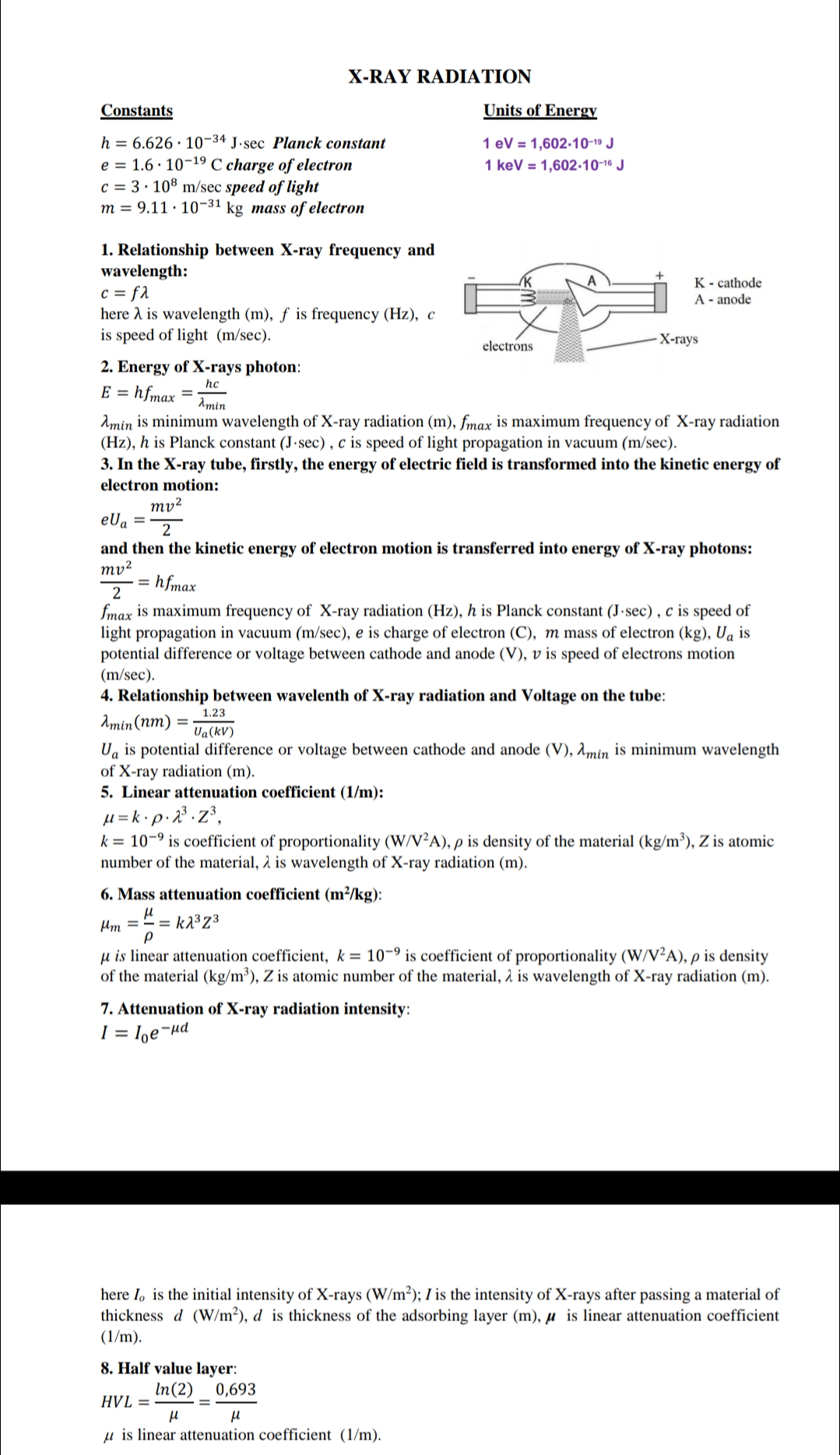X-RAY RADIATION Constants Units of Energy h = 6.626 · 10-34 J.sec Planck constant 1 eV = 1,602-10-19 J e = 1.6 · 10-19 C charge of electron c = 3· 10® m/sec speed of light m = 9.11 · 10-31 kg mass of electron 1 keV = 1,602.10-16 J 1. Relationship between X-ray frequency and wavelength: K - cathode A - anode c = f1 here A is wavelength (m), ƒ is frequency (Hz), c is speed of light (m/sec). X-гаys electrons 2. Energy of X-rays photon: hc E = hfmax = Amin Amin is minimum wavelength of X-ray radiation (m), fmax is maximum frequency of X-ray radiation (Hz), h is Planck constant (J·sec), c is speed of light propagation in vacuum (m/sec). 3. In the X-ray tube, firstly, the energy of electric field is transformed into the kinetic energy of electron motion: ту? eUa 2 and then the kinetic energy of electron motion is transferred into energy of X-ray photons: mv? = hfmax 2 fmax is maximum frequency of X-ray radiation (Hz), h is Planck constant (J·sec), c is speed of light propagation in vacuum (m/sec), e is charge of electron (C), m mass of electron (kg), Ua is potential difference or voltage between cathode and anode (V), v is speed of electrons motion (m/sec). 4. Relationship between wavelenth of X-ray radiation and Voltage on the tube: 1.23 Amin (пт) Ua(kV) U, is potential difference or voltage between cathode and anode (V), Amin is minimum wavelength of X-ray radiation (m). 5. Linear attenuation coefficient (1/m): µ = k•p• 2³ •Z³, k = 10-9 is coefficient of proportionality (W/V²A),p is density of the material (kg/m³), Z is atomic number of the material, 2 is wavelength of X-ray radiation (m). 6. Mass attenuation coefficient (m²/kg): =" = ka³Z3 и µ is linear attenuation coefficient, k= 10-9 is coefficient of proportionality (W/V²A), p is density of the material (kg/m³), Z is atomic number of the material, 2 is wavelength of X-ray radiation (m). 7. Attenuation of X-ray radiation intensity: I = I̟e-µd here I, is the initial intensity of X-rays (W/m²); I is the intensity of X-rays after passing a material of thickness d (W/m²), d is thickness of the adsorbing layer (m), µ is linear attenuation coefficient (1/m). 8. Half value layer: In(2)_ 0,693 HVL = и и u is linear attenuation coefficient (1/m).
Compton effect
The incoming photons' energy must be in the range of an X-ray frequency to generate the Compton effect. The electron does not lose enough energy that reduces the wavelength of scattered photons towards the visible spectrum. As a result, with visible lights, the Compton effect is missing.
Recoil Velocity
The amount of backward thrust or force experienced by a person when he/she shoots a gun in the forward direction is called recoil velocity. This phenomenon always follows the law of conservation of linear momentum.
In order to improve contract during X-ray diagnostics of soft tissues, contrast agents are
used. For example, the stomach and intestines are filled with barium sulphate ВаSO4. Compare mass
attenuation coefficients for soft tissues and for barium sulphate.

Step by step
Solved in 2 steps









